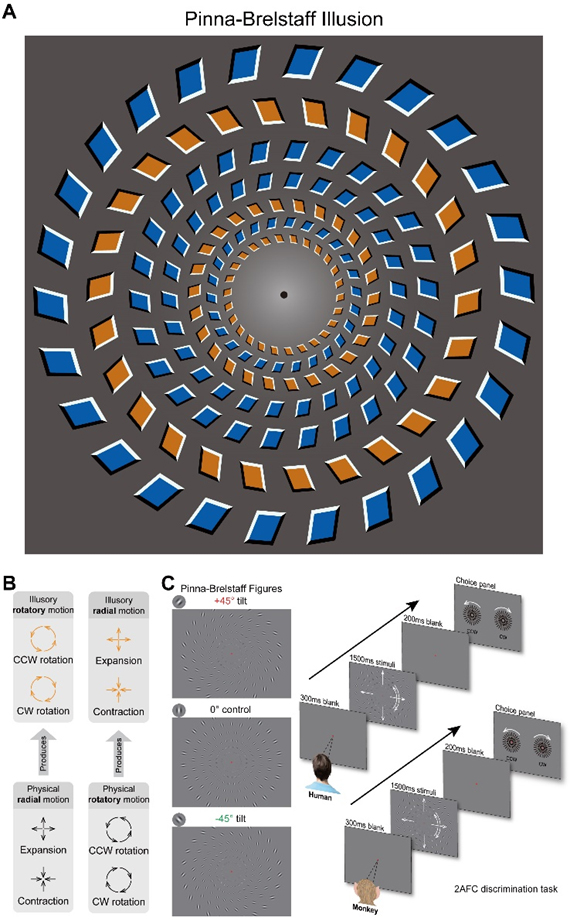Time:2019-02-18
Visual illusions have fascinated mankind for thousands of years and the study of the mismatch between perception and reality helps us to better understand the creative nature of the human visual system and ultimately may lead to deeper insights of how our brain works. The Pinna illusion is a striking example of complex-flow motion perception in the absence of physical motion. When we move towards or away from it, we experience vivid illusory counter rotation (Figure 1A below as an example). The strength and nature of this illusion critically and reliably depend on local micro-patterns such as the orientation and edge polarity of the small rhombi. Although this phenomenon is well known, where and how does this happen in the human brain? Employing human psychophysics and brain imaging methods, previous studies at the Institute of Neuroscience CAS, discovered what part of the brain illusory activity was most closely linked to (Pan et al., 2016; Wang et al., 2018). However, the neural basis of the transformation from objective reality to illusory percepts remained unknown. This is a central question in vision tackling how sensory information is integrated from local visual cues to globally perceived representations across different brain regions.

Figure 1. (A) Fixate the black dot and move your head towards and away from the image and you should perceive the rings rotating clock-wisely/count clock-wisely (CW/CCW); this variant of the Pinna illusion was designed by the first author. (B) Physical radial (left panel) and rotatory (right panel) motion of the Pinna-Brelstaff figure produce illusory rotatory and radial motions, respectively. (C) Left part: Illustration of Pinna figures used in this study, where controlling the local Gabor orientation between +45°, 0° and ?45°, carefully controls the type of illusory motion subjects perceive. Right part: the psychophysical task used in both humans and monkeys.
Researchers at the Institute of Neuroscience continued to study this issue from a novel perspective by studying the transformation from physical to four illusory flow motions (rotation, expansion, contraction, and spiral motion, Figure1B) induced by a carefully parametrized Pinna figure at both the perceptual and neuronal level. They first show psychophysically (Figure 1C) that non-human primates (macaque monkeys) have psychometric functions similar to humans, strongly suggesting that monkeys perceive illusions like human observers. Subsequent neurophysiological recordings in two brain areas (MT and MSTd) critical for serial motion processing revealed that MSTd neurons represent both physical and illusory complex-flow motion equivalently through global integration of MT local-motion signals. However these neurons in MSTd required an extra time of about 15 ms for reliably representing the illusory motion (Figure 2). By taking advantage of the unique characteristics of this stimulus, this work provides the first detailed analysis of the neuronal mechanisms underlying complex forms of illusory motion integration from MT to MSTd. Specifically, the same motion-specific neural groups in MSTd that normally encode physical flow motions also mediate illusory flow motions through a bottom-up cascade of integration of non-veridical local motion signals, yet reliable discrimination is temporally delayed for the illusion. This study provides contemporary neural-level support for the idea Jan Purkinje stated so concisely 150 years ago, that “illusions contain visual truth”.

Figure 2. Schematic summary of motion integration from local to global illusory complex-flow motion. Diagram illustrates how an example MSTd CCW rotation sensitive neuron with a large RF (top) integrates MT local motion inputs (middle) to represent global illusory CCW rotary motion from a physically expanding +45° Pinna-Brelstaff stimulus (bottom). The AUC temporal dynamics of MSTd and MT populations plotted within the MSTd RF (top circle) show the integration time window for illusory motion. The black circles represent MT and MSTd neuron RFs. Small inset on the right of the middle panel illustrates the orthogonal motion signal of MT neurons due to the aperture effect (short orange arrows in the middle panel); such biased illusory motion signals from a group of circularly arranged MT neurons are assumed to be integrated (shown by orange arrows between middle and top panel) by the MSTd neuron, resulting in global illusory CCW rotation (long orange arrows and circle in the top panel).
This work, entitled "Going with the flow: the neural mechanisms underlying illusions of complex-flow motion", was selected in "The Journal of Neuroscience" for promotion to the media with the title of ‘‘Brain Represents Optical Illusion as Delayed Reality’’ on February 12th 2019. The work was subsequently published online on February 18th 2019. This research was performed by Graduate Student Mr. LUO Junxiang and colleagues in Dr. WANG Wei’s Lab in the Institute of Neuroscience, and Center for Excellence in Brain Science and Intelligence Technology of the Chinese Academy of Sciences. Dr. GU Yong from the same Institutions has engaged in the co-supervision of Mr. LUO from the beginning of the project. This work was supported by the Strategic Priority Research Program of Chinese Academy of Sciences, Grant No. XDB32060200 and CAS project grant No. GJHZ1735; the Shanghai Municipal Science and Technology Major Project, Grant No. 2018SHZDZX05; and National Natural Science Foundation of China Grants (31571078, 31761133014 and 31861143032).
 附件下载:
附件下载: